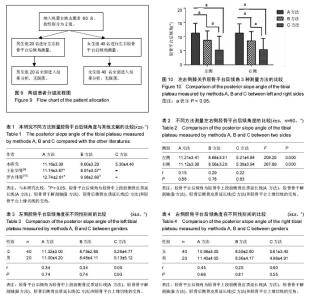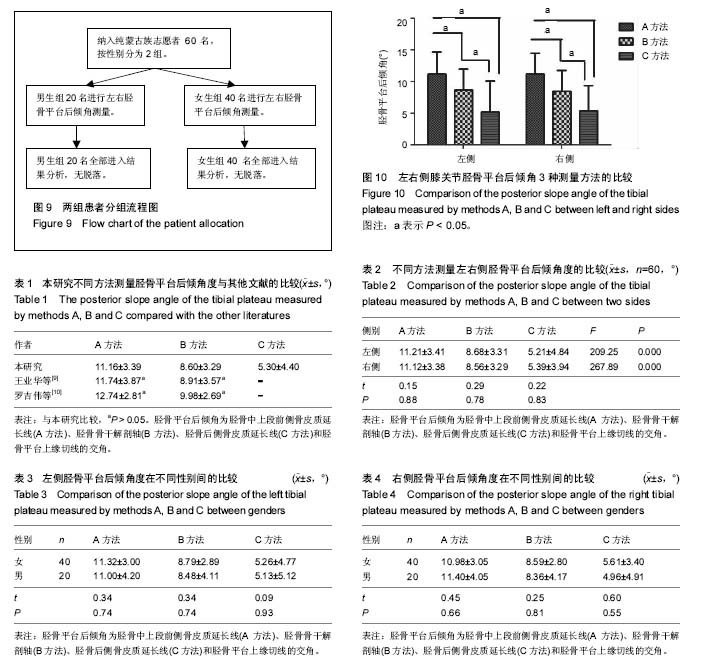| [1] Bai B, Baez J, Testa N, et al. Effect of posterior cut angle on tibial component loading. J Arthroplasty. 2000;15(7):916-920. [2] 吴羽,王振虎. 胫骨后倾角在全膝关节表面置换术中的临床应用研究[J].中国矫形外科杂志,2015, 23(21):1959-1963. [3] Lotke PA, Ecke ML. Influence of positioning of prosthesis in total replacement. J Bone Joint Surg Am. 1977;59(1): 77-83.[4] Hofmann AA,Bachus KN,Ywatt RWB.Effect of the tibial cut on subsidence following total knee arthroplasly. Clin Orthop Res. 1991;269:63-69.[5] Kapandji IA. The physiology of the Joints:Lower Limb, Volum 2 (Lower Limb) 5th ed. Churchill Livingstone: 1987.[6] Pugh JW,Radin EL,Rose RM.Quantitative studies of human subchondral cancellous bone.Its relationship to the state of its overlying cartilage. J Bone Joint Surg Am. 1974;56(2): 313-321.[7] De Boer JJ, Blankevoort L, Kingma I, et al. In vitro study of inter-individual variation in posterior slope in the knee joint. Clin Biomech (Bristol, Avon). 2009;24(6):488-492.[8] Behrooz H,Sujith K,Ken M, et al. Evaluation of the posterior tibial slope on MR images in different population groups using the tibial proximal anatomical axis. Acta Orthop Belg. 2012;78( 6) : 757-763.[9] 王业华,吕厚山,寇伯龙,等.国人胫骨内侧平台后倾角的测量及不同测量方法的比较[J]. 中国矫形外科杂志,2003 ,11(10): 694-696.[10] 罗吉伟,史占军,陈国奋,等.胫骨内侧平台后倾角的测量及其在膝关节置换术中的意义[J]. 中华关节外科杂志,2007,1(4): 238-241.[11] Goldstein SA,Wilson DL,Sonstegard DA, et al. The mechanical properties of human tibial trabecular bone as a function of metaphyseal location. J Biomech. 1983;16(12): 965-969.[12] Matsuds S,Miura H,Nagamine R,et al. Posterior tibial stope in the normal and varus knee. Am J Knee Surg. 1999;12(3): 165-168.`[13] Chiu KY, Zhang SD,Zhang GH.Posterior slope of tibial plateau in chinese. J Arthroplasty. 2000;15(2):224-227.[14] Brazier J,Migaud H,Gougeon F,et al.Evaluation of methods for radiographic measurement of the tibial slope:a study of 83 healthy knees.Rev Chir Orhtop Reparalrice Appar Mot. 1996; 82(2):195-200.[15] 王戟森,陈肩峰,潘耀城.人工膝关节置换中的胫骨平台后倾角[J].中国矫形外科杂志,2016,24(9):826-831.[16] Moore TM,Harvey JP. Roentgenograohic measurement of labial-plateau depression due to frature. J Bone Joint Surg Am.1974;56(1):155-160.[17] 张树栋,曲广运,张光辉,等.胫骨后倾角解剖与放射学测量评价[J].中华骨科杂志,2000,20(4):210-211.[18] Dejour H , Bonnin M.Tibial translation aft er anteri or cruciat e ligament rupture.Two radiological tests compared .J Bone Joint Surg(Br). 1994;76:745 -749 .[19] 曲铁兵,曾纪洲,林源,等.华北地区成人正常胫骨内侧平台后倾角的测量及临床意义[J].中华骨科杂志,2003,23(8):455-458.[20] 李军,荆珏华,史占军,等. 华南人胫骨平台后倾角的三维测量及临床意义[J].中国临床解剖学杂志,2013,31(4):411-413. [21] 黄文华,姜楠,钟世镇,等. 胫骨平台后倾角的测量及临床意义[J].中国骨与关节损伤杂志,2007,22(10):825-828.[22] 王戟森,陈坚峰,潘耀成,等.人工膝关节置换术中的胫骨平台后倾角[J].中国矫形外科杂志,2016,9(24):826-831.[23] Pasquale S, Giulio F,Giuseppe G,et al.The risk of sacrificing the PCL in cruciate retaining total knee arthroplasty and the relationship to the sagittal inclination of the tibial plateau. Knee. 2015;22(1):51-55.[24] 齐勇,孙洪涛,樊粤光,等.胫骨后倾角对前交叉韧带及膝关节稳定性影响的三维有限元分析[J].中国运动医学杂志, 2016,8(35): 708-713.[25] Faschingbauer MM,Sgroi M,Juchems H, et al. Can the tibial slope be measured on lateral knee radiographs. Knee Surg Sports Traumatol Arthrose. 2014;22(12):3163-3167.[26] 齐勇,樊粤光,孙鸿涛,等.广东地区青壮年人胫骨平台后倾角与ACL损伤的相关性[J]. 中国运动医学杂志,2016,12(35): 1106-1111.[27] Blanke F, Kiapour AM, Haenle M, et al. Risk of noncontact anterior cruciate ligament injuries is not associatedwith slope and concavity of the tibial plateau in recreational alpine skiers:A magnetic resonance imagingbasedcase-control study of 121 patients. Am J Sports Med. 2016.[Epub ahead of print][28] 王斌,徐青镭,孙磊. 胫骨平台后倾角与非接触性前交叉韧带损伤的相关性[J].中国矫形外科杂志,2015,23(12):1083-1085.[29] 贺忱,李方祥.胫骨平台倾斜角与非接触性前交叉韧带损伤相关性研究[J].中国运动医学杂志,2014,33(9):847-854.[30] Li Y, Hong L, Feng H, et al. Are failures of anterior cruciate ligament reconstruction associated with steep posterior tibial slopes? A case control study.Chin Med J(Engl).2014;127(14): 2649-2653. |

